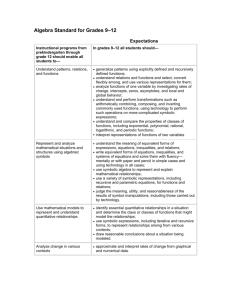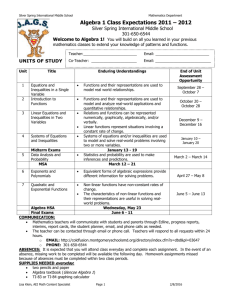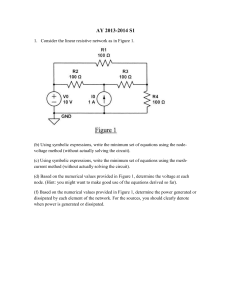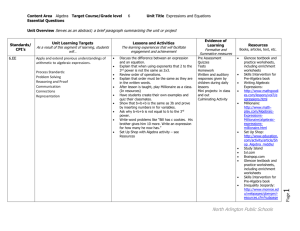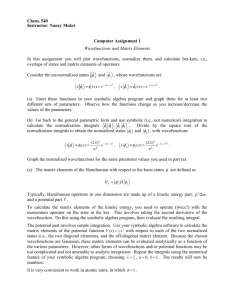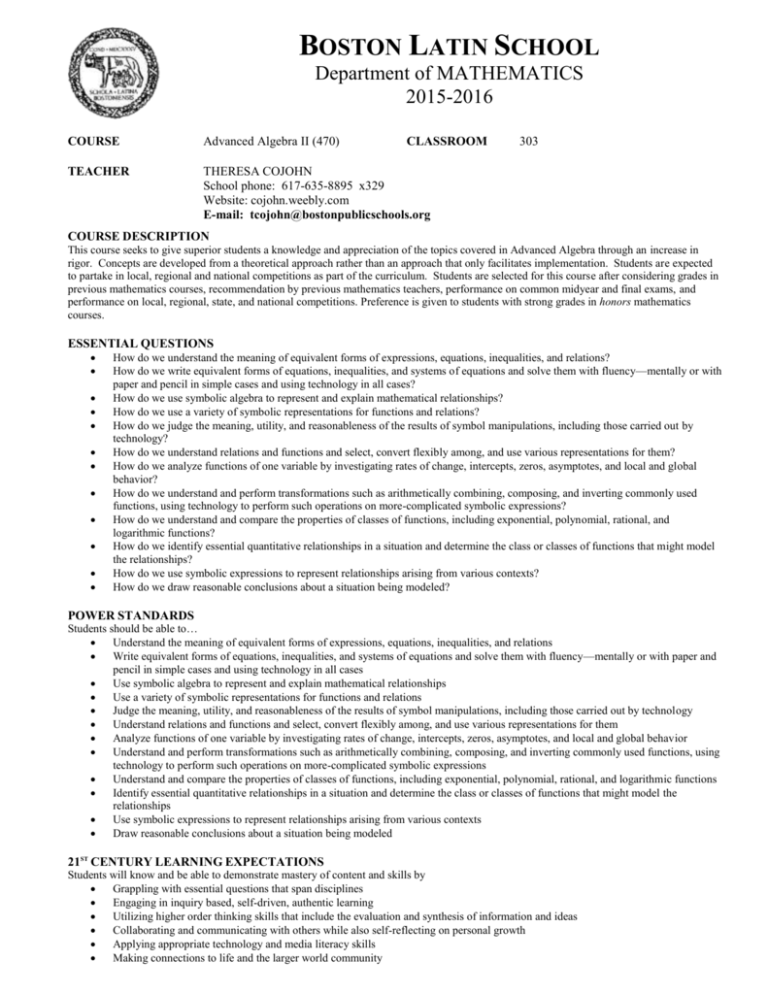
BOSTON LATIN SCHOOL
Department of MATHEMATICS
2015-2016
COURSE
Advanced Algebra II (470)
CLASSROOM
TEACHER
THERESA COJOHN
School phone: 617-635-8895 x329
Website: cojohn.weebly.com
E-mail: tcojohn@bostonpublicschools.org
303
COURSE DESCRIPTION
This course seeks to give superior students a knowledge and appreciation of the topics covered in Advanced Algebra through an increase in
rigor. Concepts are developed from a theoretical approach rather than an approach that only facilitates implementation. Students are expected
to partake in local, regional and national competitions as part of the curriculum. Students are selected for this course after considering grades in
previous mathematics courses, recommendation by previous mathematics teachers, performance on common midyear and final exams, and
performance on local, regional, state, and national competitions. Preference is given to students with strong grades in honors mathematics
courses.
ESSENTIAL QUESTIONS
How do we understand the meaning of equivalent forms of expressions, equations, inequalities, and relations?
How do we write equivalent forms of equations, inequalities, and systems of equations and solve them with fluency—mentally or with
paper and pencil in simple cases and using technology in all cases?
How do we use symbolic algebra to represent and explain mathematical relationships?
How do we use a variety of symbolic representations for functions and relations?
How do we judge the meaning, utility, and reasonableness of the results of symbol manipulations, including those carried out by
technology?
How do we understand relations and functions and select, convert flexibly among, and use various representations for them?
How do we analyze functions of one variable by investigating rates of change, intercepts, zeros, asymptotes, and local and global
behavior?
How do we understand and perform transformations such as arithmetically combining, composing, and inverting commonly used
functions, using technology to perform such operations on more-complicated symbolic expressions?
How do we understand and compare the properties of classes of functions, including exponential, polynomial, rational, and
logarithmic functions?
How do we identify essential quantitative relationships in a situation and determine the class or classes of functions that might model
the relationships?
How do we use symbolic expressions to represent relationships arising from various contexts?
How do we draw reasonable conclusions about a situation being modeled?
POWER STANDARDS
Students should be able to…
Understand the meaning of equivalent forms of expressions, equations, inequalities, and relations
Write equivalent forms of equations, inequalities, and systems of equations and solve them with fluency—mentally or with paper and
pencil in simple cases and using technology in all cases
Use symbolic algebra to represent and explain mathematical relationships
Use a variety of symbolic representations for functions and relations
Judge the meaning, utility, and reasonableness of the results of symbol manipulations, including those carried out by technology
Understand relations and functions and select, convert flexibly among, and use various representations for them
Analyze functions of one variable by investigating rates of change, intercepts, zeros, asymptotes, and local and global behavior
Understand and perform transformations such as arithmetically combining, composing, and inverting commonly used functions, using
technology to perform such operations on more-complicated symbolic expressions
Understand and compare the properties of classes of functions, including exponential, polynomial, rational, and logarithmic functions
Identify essential quantitative relationships in a situation and determine the class or classes of functions that might model the
relationships
Use symbolic expressions to represent relationships arising from various contexts
Draw reasonable conclusions about a situation being modeled
21ST CENTURY LEARNING EXPECTATIONS
Students will know and be able to demonstrate mastery of content and skills by
Grappling with essential questions that span disciplines
Engaging in inquiry based, self-driven, authentic learning
Utilizing higher order thinking skills that include the evaluation and synthesis of information and ideas
Collaborating and communicating with others while also self-reflecting on personal growth
Applying appropriate technology and media literacy skills
Making connections to life and the larger world community
READING SYLLABUS
Algebra & Trigonometry 7th Edition by Sullivan; Publisher: Pearson/Prentice Hall
ISBN: 0-13-143073-4
SUPPLIES AND EQUIPMENT
TI-83 or TI-84 graphing calculator (Casio, TI-89 and TI-Inspire are not allowed)
3-hole graph paper (size 8.5 X 11) to do homework on
3-ring binder (1 inch with plastic insert for cover sheet) and dividers
Memory Stick
GRADING
Your grades each term will be calculated using a points-based grading system. The student receives points for completed assignments, projects,
quizzes and tests and the term grade is determined by the number of points earned out of the number of possible points.
Final Grade: 1st term 25%, 2nd term 25%, 3rd term 25%, 4th term 25%
COMMON ASSESSMENTS
In addition to frequent formative assessments, the following will be administered to all students enrolled in this course:
Mid year exam and final exam
HOMEWORK
Homework assignments are given to help students learn the material in the class and to develop good reasoning and problems
solving skills. The expectation is that students will do each night’s assigned homework.
The Math Department Homework Policy:
If a student completes all homework assignments then 2 percentage points will be added to his or her term average.
If a student completes all but two or fewer homework assignments then the term average is unaffected.
If a student misses more than two homework assignments in a term then he or she will lose 1 percentage point from the
term average for each assignment missed.
CONDUCT
Students’ active participation in classroom work and discussions is an integral part of the learning atmosphere in class. Students
are responsible for all the work covered in class when they are absent from school. Any work or assessments missed due to
EXCUSED absences must be made-up within 3 days of return with a note. Make-ups are the student’s responsibility.
Students are expected to be respectful in their attitude toward one another, the teacher and will behave in accordance with the
BLS Student Handbook. You will receive 1 mm for each of the following minor offenses: tardy to class, failure to bring textbook
to class, failure to have textbook covered properly, speaking out of turn, etc.
OFFICE HOURS
7:00-7:30 A.M. by appointment only
2:20-3:00 P.M. by appointment only
Parents please e-mail to make an appointment
Students please see me during class to make an appointment
Students and Parents:
Please read the above information for Advanced Algebra II together, and indicate by your signatures that you understand the
purpose, format, and expectations of this course. Please feel free to see, call, or e-mail me with any questions or problems you
might have.
Student:
I have read and I understand the course description and classroom expectations for Advanced Algebra II.
Student’s Name Printed: ___________________________________________________________
Student’s Signature:
_________ Date
Parent/Guardian:
I have reviewed the course description and classroom expectations for Advanced Algebra II with my son or daughter.
Parent/Guardian’s Name Printed:
_____________________________________________________
Parent/Guardian’s Signature:
Parent/Guardian’s Phone:
Date
___

